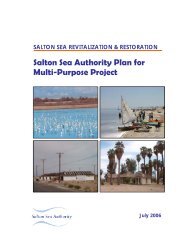Salton Sea Preliminary In-Sea Geotechnical Investigation
Salton Sea Preliminary In-Sea Geotechnical Investigation
Salton Sea Preliminary In-Sea Geotechnical Investigation
Create successful ePaper yourself
Turn your PDF publications into a flip-book with our unique Google optimized e-Paper software.
SECTIONFIVE<strong>Preliminary</strong> Engineering CharacterizationThe compressibility characteristics of fine-grained materials have been interpreted from laboratoryoedometer testing and published correlations to index properties. Correlations to index properties wereused to interpret potential variability, considering the limited number of oedometer tests performed withineach deposit compared to the more numerous index testing. For example, the Liquidity <strong>In</strong>dex (LI)provides qualitative assessments of the compressibility of fine-grained soils.LI is defined as:LI = (w-PL)/PIWhere: w = water contentPL = plastic limitPI = plasticity indexA LI less than or equal to zero may indicate a heavily overconsolidated soil. A LI equal to 1.0 may indicaterelatively weak and compressible materials. A LI greater than 1.0 may indicate that the material is sensitive.Soils with a LI greater than approximately 0.7 may experience significant consolidation settlements.The parameters used to characterize compressibility are the Compression <strong>In</strong>dex (C c ), Recompression<strong>In</strong>dex (C r ), Overconsolidation Ratio (OCR or σ p ’ /σ v ’ ) and/or Preconsolidation Pressure (σ p ’), Coefficientof Secondary Compression (C α ) and the Coefficient Consolidation (c v ).The C c was interpreted as the slope of the oedometer test data in the range of the anticipated stresschanges, as shown below:C c = ∆e / ∆ log σ v 'Where: ∆e = change in void ratio∆σ v ’ = change in effective vertical overburden stressThe C r has been interpreted from the reloading portion of the laboratory oedometer testing, or taken to bethe commonly adopted values of ten to twenty percent of C c .The Overconsolidation Ratio (OCR) and Preconsolidation Pressure (σ p ’) were estimated by inspection ofthe strain – log σ’ oedometer test data and various published correlations to index parameters.The Compression Ratio (CR) is related to C c as follows:CR = C c / (1 + e 0 )Where: e 0 = initial void ratioThe CR is also commonly related to natural water content; a plot of published correlations with test datafrom this investigation is shown in Figure 23.Conceptual design parameters for secondary compression have not been developed for this study. Themagnitude of secondary compression should provide a relatively small contribution to overall settlement,or be part of a long-term maintenance burden, depending on the design life adopted.W:\27663042\00005-c-r.doc\1-Mar-04\SDG 5-3



